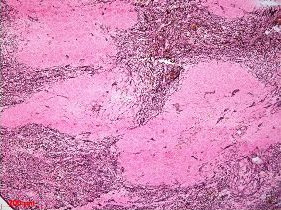Fibroblasts (Pan Reticular) Rat Monoclonal Antibody [Clone ID: ER-TR7]
CAT#: BM4018S
Fibroblasts (Pan Reticular) rat monoclonal antibody, clone ER-TR7, Purified
Specifications
| Product Data | |
| Clone Name | ER-TR7 |
| Applications | FC, IF, IHC |
| Recommended Dilution | Immunohistochemistry on Frozen Sections (Ref.1,2): Sections were stained using an Iindirect immunoperoxidase method (Ref.1). Immunohistochemistry on Paraffin Sections: Formalin fixed paraffin sections were deparafined, hydrated in ethanol and stained with ER-TR7 for 30’at RT (Ref.3). Flow Cytometry: Splenocytes were incubated with ER-TR7 for 30’ (Ref.4). Immunofluorescence (Ref.4-6): Acetone or PFA fixed cells were quenched with 50mM NH4Cl for 30’, blocked and permeabilized with 1.5% Goat serum/0.1% saponin in PBS for 45’ ate RT. Incubation of ER-TR-7 in block&perm solution for 45’ at RT. Specific staining was detected with a fluorescent conjugated Goat anti-Rat-IgG (Ref.5). Positive Control: Spleen. Negative Control: Lymphoid cells. Typical Starting Working Dilutions: 1/50 for Immunohistochemistry and Flow Cytometry. |
| Reactivities | Human, Mouse |
| Host | Rat |
| Isotype | IgG2a |
| Clonality | Monoclonal |
| Immunogen | Mouse thymic stromal cells. |
| Specificity | This Monoclonal antibody ER-TR7 recognizes with an intracellular component of Mouse Fibroblasts. The ER-TR7 antigen is a ubiquitous component of stromal (interstitial) matrix cartilage and of at least some basement membrane zones. The antigen detected is not a basement membrane component, nor any major collagen type or fibronectin. The antigen detected has a wider tissue distribution than reticulin. ER-TR7 detects an intracellular component of fibroblasts. Since ER-TR7 does not react with purified laminin, collagen types I-V, fibronectin, heparin sulfate proteoglycan, entactin or nidogen, it detects a hitherto uncharacterized antigen. The Monoclonal antibody ER-TR7 can be used to study the micro-anatomy of various organs. ER-TR7 outlines the various compartments of peripheral lymphoid organs by characteristic labeling patterns (no such compartments are found in central lymphoid organs). Furthermore ER-TR7 delineates various types of connective tissue compartments in nonlymphoid organs. The antibody ER-TR7 detects reticular fibroblasts, which constitute the cellular framework of lymphoid and nonlymphoid organs and their products. ER-TR7 is useful to clearly delineated the follicles, periarteriolar lymphoid sheath and marginal zone; the major white pulp compartments. Furthermore in lymph nodes, the capsule, sinuses, follicles, paracortex and medullary cords are clearly delineated. |
| Formulation | PBS State: Purified State: Liquid 0.2 µm filtered Ig fraction Stabilizer: 0.1% BSA Preservative: 0.02% Sodium Azide |
| Concentration | 0.1 mg/ml |
| Purification | Affinity Chromatography on Protein G |
| Background | Fibroblasts are the least specialized cells in the connective-tissue family. They are dispersed in connective tissue throughout the body, where they secrete a nonrigid extracellular matrix (ECM) that is rich in type I and/or type III collagen. Conective tissue consists of glycosaminoglycans, proteoglycans and glycoproteins through which various fibres run. These fibres can be collagenous, elastic or reticular. Reticular fibres are composed from the family of collagen proteins and give tensile strength. These fibres are made by reticular fibroblasts. The activation of fibroblasts by inflammatory stimuli results in their migration, proliferation and deposition of extracellular matrix components, important features involved in both wound healing and fibrosis. |
| Synonyms | Fibroblast Marker, Fibroblasten |
| Reference Data | |
Documents
| Product Manuals |
| FAQs |
| SDS |
{0} Product Review(s)
0 Product Review(s)
Submit review
Be the first one to submit a review
Product Citations
*Delivery time may vary from web posted schedule. Occasional delays may occur due to unforeseen
complexities in the preparation of your product. International customers may expect an additional 1-2 weeks
in shipping.






























































































































































































































































 Germany
Germany
 Japan
Japan
 United Kingdom
United Kingdom
 China
China



